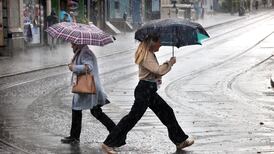A little animal, curled up and sleeping, nose to furry tail, like a strokable netsuke, tumbled out of a bag of hay in front of a reader in Co Kildare earlier this month. He sent a picture and asked Eye on Nature for a name. He had found a hibernating dormouse; a hazel dormouse, to name it in full, or Muscardinus avellanarias, or even luch chodlamáin .
It was the latest appearance of the most recent addition to Ireland’s small mammal community. Hazel dormice have arrived within the past decade, most probably, as their DNA hints, in bales of upmarket hay imported from France for a Kildare racehorse stud.
A local "citizen science" survey in 2013 gave the animals (some asleep in gardeners' empty flowerpots) a range of some 30 sq km around Newbridge and Naas. Some increase since then is suggested in their sweetly illustrated profile in the new Atlas of Mammals in Ireland 2010-2015.
This landmark publication maps the distribution of 77 mammal species recorded in Ireland or swimming in its marine “territory” right out to the deep Atlantic. It makes a handsome, large-format book, published by the National Biodiversity Data Centre at €30.
Its maps distil almost a quarter of a million records existing in 37 different data sets up to 2010, and then match them to current sightings contributed by more than 2,000 recorders. The latter are certainly indicative, but the variable effort and number of keen observers leaves a ribbon of meagre records running down the west coast.
Engrossing
In one of the book's engrossing essays, Prof Ian Montgomery reviews the periods at which mammals arrived in Ireland. His story begins about 12,000 years ago, but as many new species have been added in the past 100 years as in the previous 10,000. Among the most recent are invasive species of shrew and vole that threaten native ecosystems.
Dr Colin Lawton reviews the growth of research into Ireland's "unique mammal community, different to that found anywhere else in the world". The island has its own subspecies of stoats and hares. Others have adapted to very different habitats from those of their British cousins, with fewer competitors, predators or prey, so that data from our sister island can be misleading.
The same point was made half a century ago by the zoologist James Fairley, Dr Lawton's predecessor at NUI Galway. He pioneered popular interest in Irish mammals with his An Irish Beast Book in 1975 and compiled the first edition of Irish Wild Mammals: A Guide to the Literature in 1972. Coinciding with the new atlas, a fourth and much enlarged edition of this guide is published by Dr Pat Smiddy and Dr Paddy Sleeman of University College Cork.
A new field of research opened up in the 1990s with DNA analysis. It offers fresh evidence on the origin of Ireland’s mammals, a genetic heritage leading often to Iberia and Europe. It casts new light on introductions of the red deer dating back to the Neolithic era, and traces origins of the new, invasive species, such as the greater white-toothed shrew, from France. This is now replacing the native pygmy shrew in many southern areas, a rapid spread shown in the new atlas.
Encouraging picture
From the atlas, the general picture of our mammals is encouraging. Britain’s hedgehogs, for example, have been showing a drastic decline, but a “huge effort” by Irish field observers shows them still widely abroad in Ireland’s lowlands. The red squirrel is returning to parts of the midlands where pine martens, it seems, have driven out the greys. Hares, badgers and foxes are all “extremely widespread” and often sighted.
The book brings home the large share of our species taken up by whales and dolphins. Its 25 cetaceans form by far the largest mammal group among the 68 breeding or visiting species, more than twice the diversity of the island’s 11 bats, for example.
A great growth in cetacean research has sprung from the voluntary Irish Whale and Dolphin Group (IWDG) and the sanctuary secured for these mammals in Irish waters in 1991. Dr Simon Berrow, founder of the IWDG, describes his long study of the 120-odd bottlenose dolphins of the Shannon estuary. Other members of the group describe cetaceans seen around our coasts or on research cruises far out in the Atlantic.
Biggest of them all, with a 12-metre “blow” at the surface, the blue whale can be claimed from rare sightings above the slopes of the Porcupine Seabight or the Rockall Trough. Any island whose mammals range from the great míol mór gorm of ocean swells to the little luch chodlamáin of hazelnut trees can’t be doing too badly.
Michael Viney's Reflections on Another Life, a selection of columns from the past four decades, is available from irishtimes.com/irishtimesbooks









